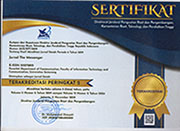Determinants of Attitudes Towards Web Advertising: An Evidence from Malaysia
Abstract
The purpose of this study is to examine the factors which influence of the consumer s Attitudes Towards Web Advertisement (ATWA). Drawing conceptual framework from Elaboration Likelihood Model (ELM), the influence of the six independent variables have been analyzed in this study, including informativeness, entertainment, credibility, economic value, interactivity, and materialism. The data has been obtained from 384 Honda users by using online questionnaires. Results of multiple regression analysis have revealed that all six factors influenced the attitude towards Honda web advertising. However, it has been revealed that the informativeness is a most important predictor of the ATWA. This study has shown that Elaboration Likelihood Model is interrelated with the determinants of consumer's attitudes towards Honda web advertisement and offered managerial implication.
Keywords
Full Text:
PDFReferences
Adler, R. B., & Rodman, G. (2000). Understanding human communication. Ft Worth: Harcourt College Publishers.
Andersen, S., & Zaelke, D. (2003). Industry Genius: Inventions and People Protecting the Climate and Fragile Ozone Layer. Sheffield: Greenleaf Publishing.
Aziz, N. A., & Ariffin, A. A. M. (2010). Exploring Consumers Attitude towards Web Advertising and its Influence on Web Ads Usage in Malaysia. Jurnal Pengurusan, 31, 55 63.
Belch, G., & Belch, M. (2007). Advertising and promotion: An integrated marketing.
Bleier, A., & Eisenbeiss, M. (2015). Personalized online advertising effectiveness: The interplay of what, when, and where. Marketing Science, 34(5), 669 688.
Boudreau, M., & Watson, R. (2006). Internet Advertising Strategy Alignment. Internet Research, 16, 23 37.
Calfee, J., & Ringold, D. (1994). The 70% majority: enduring consumer beliefs about advertising. Journal of Public Policy & Marketing, 13, 228 238.
Carlson, J., & O Cass, A. (2010). Exploring the relationships between e €service quality, satisfaction, attitudes and behaviours in content €driven e €service web sites. Journal of Services Marketing, 24(2), 112 127.
Cho, C. H., & Leckenby, J. D. (1999). Interactivity as a measure of advertising effectiveness: Antecedents and consequences of interactivity in web advertising. Proceedings of the 1999 Conference of the American Academy of Advertising, 162 179.
Eze, U. C., & Lee, C. H. (2012). Consumers Attitude towards Advertising. International Journal of Business and Management, 7(13), 94 108. https://doi.org/10.5539/ijbm.v7n13p94
Gao, Z., Zhang, H., & Li, S. F. (2014). Consumer Attitudes Toward Advertising in the Digital Age: A China United States Comparative Study. Journal of Current Issues & Research in Advertising, 35(1), 12 28.
Goldsmith, R., & Lafferty, B. (2002). Consumer response to Web sites and their influence on advertising effectiveness. Internet Research, 12(4), 318 328.
Ham, C. D. (2017). Exploring how consumers cope with online behavioral advertising. International Journal of Advertising, 36(4), 632 658.
Honda. (2014). The Official Home of Honda Malaysia. Retrieved from http://www.honda.com.my
Jung, J., Shim, S. W., Jin, H. S., & Khang, H. (2016). Factors affecting attitudes and behavioural intention towards social networking advertising: a case of Facebook users in South Korea. International Journal of Advertising, 35(2), 248 265.
Kerr, G., Schultz, D. E., Kitchen, P. J., Mulhern, F. J., & Beede, P. (2015). Does Traditional Advertising Theory Apply to the Digital World?: A Replication Analysis Questions the Relevance Of the Elaboration Likelihood Model. Journal of Advertising Research, 55(4), 390 400.
Korgaonkar, P., Silverblatt, R., & O Leary, B. (2001). Web advertising and Hispanics. Journal of Consumer Marketing, 18(2), 134 152.
Korgaonkar, P., & Wolin, L. (2002). Web usage, advertising, and shopping: relationship patterns. Internet Research, 12(2), 191 204.
Krejcie, R. ., & Morgan, D. . (1970). Determining Sample Size for Research Activities. Determining Sample Size for Research Activities.
Li, N., & Zhang, P. (2002). Consumer Online Shopping Attitudes and Behavior: An Assessment of Research. Eighth Americas Conference on Information Systems, 508 514.
Ling, K. C., Piew, T. H., & Chai, L. T. (2010). The determinants of consumers attitude towards advertising. Canadian Social Science, 6(4), 114-126.
Lutz, R. J. (1985). Affective and Cognitive Antecedents of Attitude toward the Ad: A conceptual framework, In Psychological Processes and Advertising Effects. Theory, Research and Application, Eds., 45 46.
Mackenzie, S. ., & Lutz, R. . (1989). An empirical examination of the structural antecedents of attitude toward the ad in an advertising pre testing context. Journal of Marketing, 53(April), 48 65.
McMillan, S., Hwang, J., & Lee, G. (2003). Effects of structural and perceptual factors on attitudes toward the website. Journal of Advertiisng Research, 43(4), 400 409.
McQuail, D. (1983). Mass Communication Theory: An Introduction. London: Sage Publications Inc.
Petty, R. ., & Cacioppo, J. . (1986). The elaboration likelihood model of persuasion. In Communication and persuasion. New York: Springer.
Petty, R. E., Bri ±ol, P., & Tormala, Z. L. (2002). Thought confidence as a determinant of persuasion: The self-validation hypothesis. Journal of Personality and Social Psychology, 82(5), 722 741.
Pollay, R. ., & Mittal, B. (1993). Here s the beef: factors, determinants, and segments in consumer criticism of advertising. Journal of Marketing, 57(3), 99 114.
Raza, S. H., Bakar, H. A., & Mohamad, B. (2018). Advertising appeals and Malaysian culture norms. Journal of Asian Pacific Communication, 28(1), 61-82.
Raza, S. H., Hasnain, A., & Khan, S. W. (2018). Cross-Cultural Evaluation of the Mediation of Attitudes in Relationship of Cultural Values and Behavioral Reactions toward Web Based Advertising. South Asian Journal of Management Sciences, 12(1), 1 24.
Saadeghvaziri, F., & Seyedjavadain, S. (2011). Attitude toward advertising: mobile advertising vs. advertising-in-general. European Journal of Economics, Finance and Administrative Sciences, 28(28), 104 114.
Saeed, R., Lodhi, R., Naeem, A., Akbar, A., Sami, A., & Dustgeer, F. (2013). Consumer s Attitude towards Internet Advertising in Pakistan. World Applied Sciences Journal, 25(4), 623-628.
Schlosser, A., Shavitt, S., & Kanfer, A. (1999). Survey of Internet User s Attitude toward Internet Advertising. Journal of Interactive Advertising, 13(3), 1 21.
Siau, K., & Shen, Z. (2003). Building customer trusts in e-mail commerce. Communications of the ACM, 46(4), 91 94.
Stephen, A. T. (2016). The role of digital and social media marketing in consumer behavior. Current Opinion in Psychology, 10, 17 21.
Wang, Y., & Sun, S. (2010). Examining the role of beliefs and attitudes in online advertising: a comparison between the USA and Romania. International Marketing Review, 27(1), 87 106.
Yang, Z., Peterson, R. ., & Huang, L. (2001). Taking the pulse of internet pharmacies. Marketing Health Services, 21(2), 4 10.
Zhang, P., & Wang, C. (2005). An Empirical Study on Consumer s Perceived Value and Attitude towards Advertising. Proceedings of the 6Th Global Information Technology and Management (GITM) World Conference.
DOI: http://dx.doi.org/10.26623/themessenger.v11i1A.818
Refbacks
- There are currently no refbacks.
Copyright (c) 2019 Jurnal The Messenger
View My Stats [Jurnal The Messenger] is an International Scientific Journal, Published by the Department of Communication, Faculty of Information Technology and Communication, Universitas Semarang (Central Java, Indonesia). It is licensed under a Creative Commons Attribution 4.0 International License.



_11.jpg)




_BARCODE.jpg)
_BARCODE1.jpg)


5.png)










2.png)





